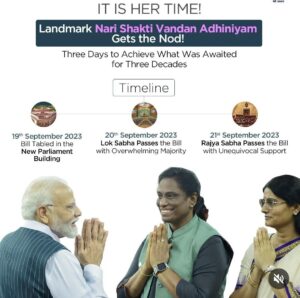Table of Contents
Women Reservation Bill: Even 75 years after the independence, Parliament lacks substantial representation from half the population, with just 14% of seats held by women, highlighting the importance of passing the “Women’s Reservation Bill” to harness women’s key role in nation building. “I measure the progress of a community by the degree of progress which women have achieved.” — Dr BR Ambedkar.
Women Reservation Bill in India
The Constitution (One Hundred and Eighth Amendment) Bill, 2008—officially known as the Women’s Reservation Bill—has been given the green light by the Union Cabinet. This crucial piece of law seeks to provide women a 33 percent representation in both the Lok Sabha and state legislative assemblies. The measure was the main topic of discussion on the first day of the extraordinary parliamentary session.
Women’s Reservation Bill 2023 Latest Update
The Nari Shakti Vandan Adhiniyam (Women’s Reservation Bill) was passed in the Rajya Sabha with 215 MPs voting in favour of the Bill.
Following extensive discussion among MPs from all parties, the Rajya Sabha approved the historic Bill that would reserve one-third of the seats in the Lok Sabha and state Assemblies for women. With 215 votes in favour and none against, the Bill was approved by a majority vote of the House.
The Constitution (One Hundred and Twenty-Eighth Amendment) law, 2023, was discussed in detail by Prime Minister Narendra Modi, who concluded the discussion by saying, “This law would lead to a new confidence in the people of the country. Additionally, it demonstrates the optimistic outlook of all political parties, which will revitalise the movement for women’s emancipation.”

The women’s reservation bill was passed by the Lok Sabha on Wednesday a day early, opening the way for the historic law. There were 454 votes in favour and two votes against it from the AIMIM.
After a day-long debate, the historic Nari Shakti Vandan Adhiniyam, also known as the Women’s Reservation Bill, was approved by the Lok Sabha with 454 votes, with only two MPs voting against it. The Women Reservation Bill is still being debated and discussed by Rajya Sabha members.
- Different constituencies in the state or union territory may receive reserved seats through a rotational allocation process.
- After 15 years from the start of this Amendment Act, the seats reserved for women will no longer be available.
- A Joint Parliamentary Committee was consulted after the bill’s initial introduction in 1996. The Lok Sabha’s dissolution caused it to expire, necessitating its reintroduction. It was repeatedly introduced and experienced setbacks in 1998 and 1999.
- In 2010, the bill was passed in the Rajya Sabha and lapsed in the Lok Sabha. Since then, it has been pending and reservations for women in Parliament are yet to be implemented.
- Percentage of Seats: The proposed bill suggests that 33% of the seats in both the Lok Sabha (the lower house of Parliament) and state legislative assemblies would be reserved specifically for women. This means that one-third of the total seats in these legislative bodies would be set aside for female candidates.
Need for the Women’s Reservation Bill in India
- Underrepresentation of women: Currently, just 14 per cent of Lok Sabha MPs are women (78 in total). And women make up roughly 11 per cent of the Rajya Sabha.
- Global comparison: Although the number of women MPs has increased significantly since the first Lok Sabha, it still remains much lower in comparison to several other countries. According to data from PRS, Rwanda (61 per cent), South Africa (43 per cent) and even Bangladesh (21 per cent), are ahead of India in this matter. India ranks 144 out of 193 countries in the representation of women in Parliament, according to the Inter-Parliamentary Union’s latest report.
- Need to bridge the gender gap: According to various international reports, development in India is being severely hampered by the breadth of the gender gap and limited female participation in traditionally male-dominated institutions and social strata
- Gender sensitization in law-making: As a study by the American Economic Association showed, “countries with a higher share of women in national parliament are more likely to pass and implement gender-sensitive laws.”
- Positive impacts: A 2010 study by the Harvard Kennedy School showed that female representation in village councils increased female participation and responsiveness to concerns such as drinking water, infrastructure, sanitation and roads.
Global Examples Related to Women’s Reservation
- Around the world, women leaders are outperforming their male counterparts.
- The Scandinavian countries have implemented policies and governance structures that support gender equality and women’s empowerment, which includes women’s representation in political and leadership positions.
- Norway implemented a quota system in 2003 that required 40% of seats on corporate boards to be occupied by women.
- Moreover, countries led by women have shown to have some of the best policies and governance practices.
- The deep scars in Rwanda, a central African nation, from the genocide, are being healed by predominantly a leadership that comprises women; this has also resulted in key social reforms.
Provisions for Women’s Political Empowerment in Indian Constitution
- Article 15 (3): The State is empowered to make “special provisions”, legislative or otherwise, to secure women’s socio-political advancement.
- Article 325: Guarantees equal rights for both sexes, and entitles women to enjoy economic, social, cultural, and political rights on an equal footing with men.
Women’s Reservation Bill [The Constitution (108th Amendment) Bill, 2008]: Background
- Origination of women’s reservation in India:
- The discourse on women’s reservation in India can be traced back to 1955 when a government-appointed committee recommended that 10% of seats in the Lok Sabha and State legislative assemblies should be reserved for women.
- However, it was not until the 1980s that the demand for women’s reservations gained momentum.
- The National Perspective Plan for Women (1988) recommended that 30% of seats in all elected bodies should be reserved for women.
- The Journey of Women’s Reservation Bill: The Women’s Reservation Bill (Constitution (108th Amendment) Bill, 2010) has witnessed a troubled journey in Parliament and has been opposed on many grounds.

- Key provisions of the Women’s Reservation Bill:

Women’s Reservation Bill History with Timeline
| Year | Events |
| 1931 |
|
| 1947 |
|
| 1971 |
|
| 1988 |
|
| 1992 | The enactment of the 73rd and 74th amendments to the Indian Constitution mandated:
|
| 1996 |
|
| 1998 |
|
| 2008 |
|
Arguments in Favour of and Against the Women’s Reservation Bill
| Arguments supporting the bill | Arguments against the bill |
|
|


 UPSC CMS Admit Card 2025 Out: Download L...
UPSC CMS Admit Card 2025 Out: Download L...
 Admiralty (Jurisdiction and Settlement o...
Admiralty (Jurisdiction and Settlement o...
 UPSC Study Material for Prelims & Ma...
UPSC Study Material for Prelims & Ma...





















